Our Stones
Please browse through the story of our stones; here you will find information on the stones that we feature in our beautiful jewelry creations.
Please browse through the story of our stones; here you will find information on the stones that we feature in our beautiful jewelry creations.
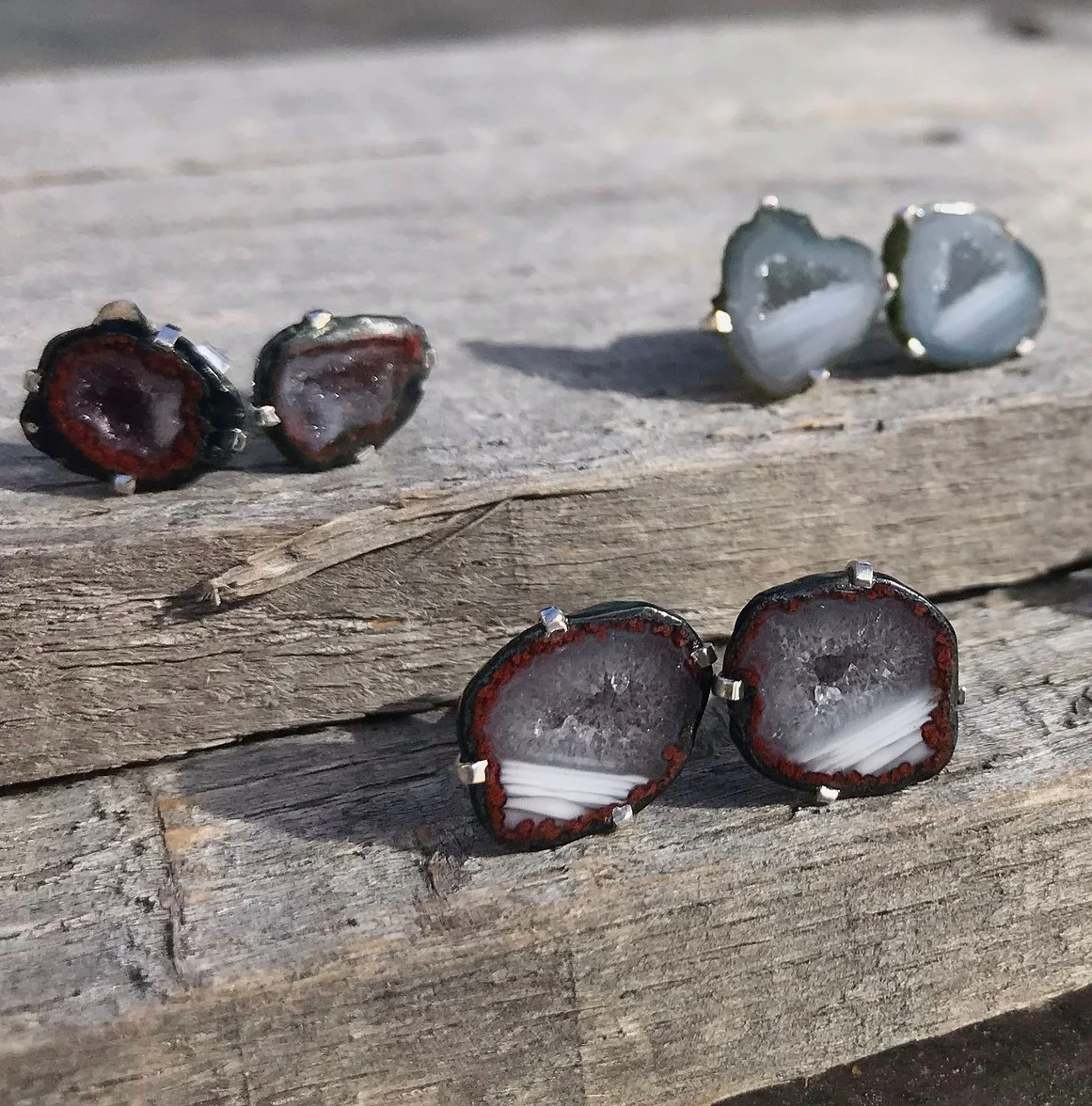
Origins: Agate is a popular variety of chalcedony (definition: a cryptocrystalline [aka microcrystalline – composed of fine crystals] form of silica composed of very fine intergrowths of the minerals quartz and moganite) that is characterized by its fine grain and bright color. Agates can feature a wide range of colors, including white, blue, red, green, yellow, orange, brown, pink, purple, gray, and black. Because agates have slightly larger fibrous quartz crystals, they are, in most cases, translucent.
Agates can occur in all mineral environments, but they are most prevalent in igneous (definition: having solidified from lava or magma) rocks. They can, however, occur in certain metamorphic (definition denoting rock that has undergone transformation by heat, pressure, or other natural agencies) rocks as well. Most agates occur as nodules in volcanic rocks, ancient lavas, or in former cavities produced by volatiles in the original molten mass, which were then filled by siliceous matter; alternatively, agates have also been known to fill veins or cracks in volcanic or altered rock underlain by granitic intrusive masses. These agates, when cut transversely, give a banded appearance to the section and are known as banded agate, riband agate, and striped agate.
Locations of Deposits: Australia, Brazil, China, India, Madagascar, Mexico, Mongolia, Namibia, Poland, the United States (Arizona, Michigan, Michigan, Oregon, South Dakota, & Wyoming), and Uruguay
History: Agate was discovered and named by the Greek philosopher, Theophrastus, sometime between the 4th and 3rd centuries B.C. Agate is commonly used in the art of hardstone carving and is often cut into slabs. Some legends claim that Agate can protect its wearer from danger.
Metaphysical Properties: Agates are stones of protection, strength, and harmony. They are great for balancing emotional, physical, and intellectual energy.
Other Information:
Agate deposits are generally extensive, so agate is known as a very affordable stone; however, a fine and sharp banded pattern, combined with natural strong coloring, may quickly increase the stone’s cost
There is an abundance of agate names, which include but are not limited to: Blue Lace Agate, Dendritic Agate, Fire Agate, Laguna Agate, Moss Agate, and Sardonyx
Many agates are often dyed; hot pink, blue, and green.
Origins: Agate geodes are rock cavities with internal quartz crystal formations or concentric banding. “Druse” refers to a coating of fine crystals on a rock fracture surface, vein, vug (definition: a small to medium-sized cavity inside rock that may be formed through a variety of processes), or within a geode.
Metaphysical Properties: Agate geodes carry the same metaphysical properties as other agate crystals. In addition, though, geodes are believed to help one see situations from different viewpoints and to help shape someone’s future. Agate geodes are thought to be especially powerful in alleviating stress and strengthening spirituality.


Origins: Stalactites are formed at the roof of a cave when mineral-rich water drips down, leaving a thin ring-like deposit of calcite. Over time, the layers of calcite build upon each other to create a column of minerals. Amethyst stalactites are cut into slices to expose the core. The composition of ground water and other factors can affect the color and denseness of the core rings.
Metaphysical Properties: Stalactites are associated with hidden inner growth and secret expansion of the higher self.
Origins: Ammonites are extinct, squid-like creatures that once lived inside coil-shaped shells. They were predatory cephalopods that had sharp, beak-like jaws inside a ring of tentacles, which extended to grab their prey. Some grew to more than three feet across.
Locations of Fossils: China, India, Madagascar and Canada (Alberta)
History: Ammonites are named after the Egyptian god Ammon, who is often depicted with ram’s horns behind each ear. They are one of the most well-known fossils, and they went extinct with the dinosaurs 65 million years ago.
Metaphysical Properties: Ammonites draw away negative energies and release them as positive energies. They are also thought to increase stamina and vitality.
Other Information:
Ammolites are Ammonite fossils that display iridescence due to compression and mineralization of the Ammonite fossil.
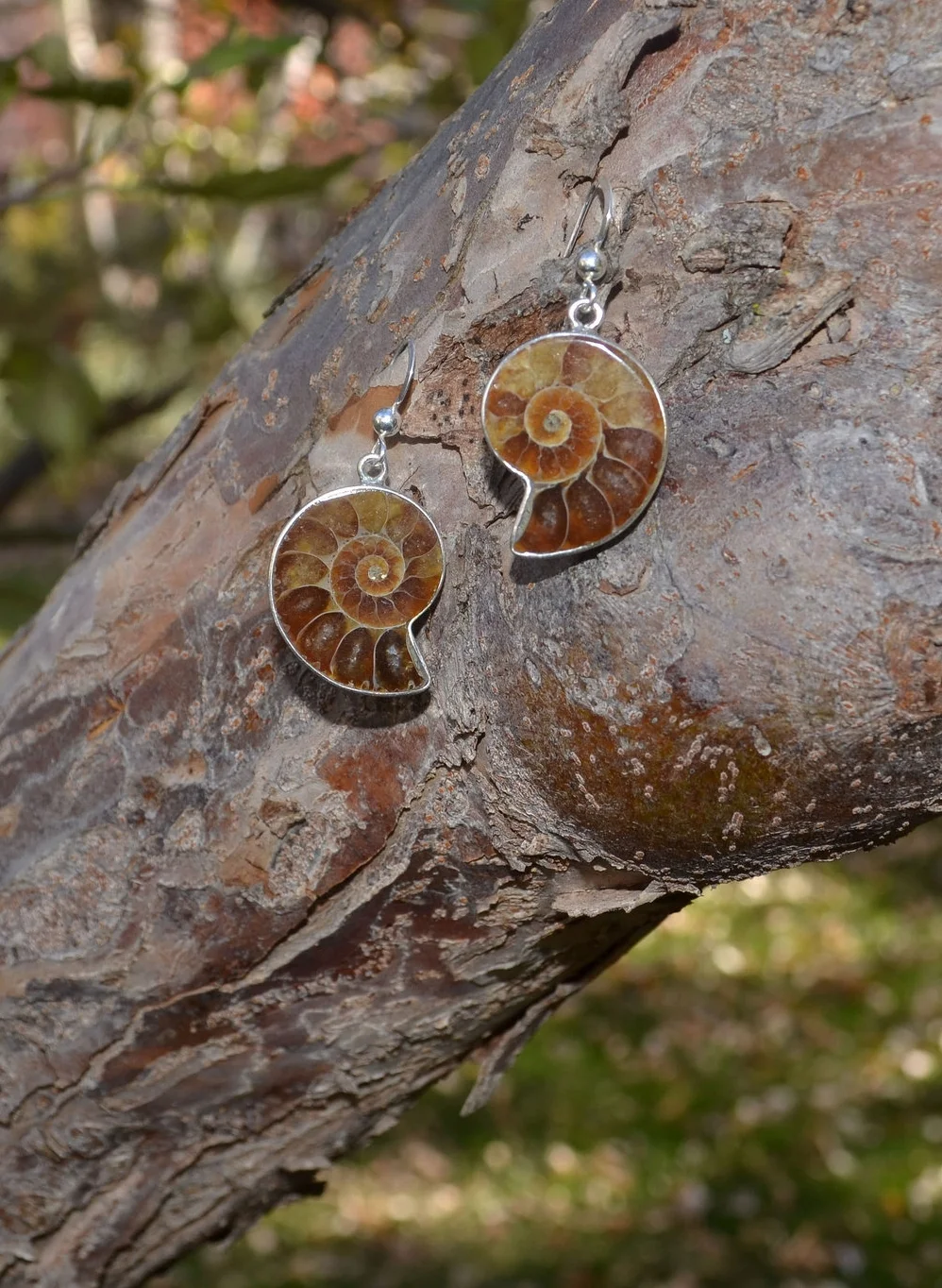

Origins: Aquamarine is a blue or cyan variety of beryl (definition: a mineral composed of beryllium aluminum cyclosilicate); other beryls include emerald [green beryl] and morganite [pink beryl]
Locations of Deposits: Brazil, China, Colombia, Kenya, Madagascar, Malawi, Mozambique, Myanmar (Burma), Namibia, Pakistan, Russia, Tanzania, the United States (Colorado, California, Idaho, & Wyoming), and Zambia
History: The word aquamarine comes from the Latin “aqua marina”, meaning “water of the sea”. In ancient times, aquamarine was used by sailors as a talisman of good luck, fearlessness and protection.
Metaphysical Properties: Aquamarine is a stone of peace, courage, and communication. It is said to be most powerful as a meditation stone because it brings great peace and serenity. It emits a compassionate and gentle energy, and as a stone of natural justice, it gives quiet courage and utilizes compromise. Additionally, it helps to overcome fear of speaking and accelerates intellectual reasoning processes. Aquamarine protects those journeying by the sea and alleviates fear of water.
Monikers:
“Stone of the Sea”
Other Information:
March birthstone
19th anniversary gemstone
Colorado state gemstone
Aquamarine is often mistaken for light blue topaz, which is less expensive
Aquamarine is often heat treated to create deeper bluer hues.
Stone of the Zodiac signs of Pisces (Feb. 20 – Mar. 20), Aries (Mar. 21 – April 20), and Gemini (May 22 – June 21)
Origins: Blue Quartz is a turbid blue quartz that gets its color from inclusions of crocidolite fibers or other blue minerals, such as Dumortierite. Its color can vary from gray to deep blue. Natural Blue Quartz is translucent.
Locations of Deposits: Australia, Austria, Brazil, Canada, Colombia, Democratic Republic of Congo (Zaire), Scotland, Spain, Sweden, Switzerland, Tanzania, and the United States (Arizona, Georgia, Maine, Maryland, Massachusetts, Montana, North Carolina, New Jersey, New Hampshire, Philadelphia, Tennessee, Texas, Vermont, & Virginia)
Metaphysical Properties: Blue Quartz is thought to calm the mind, relieve stress, and ease fear.
Monikers:
“Tranquility Stone”
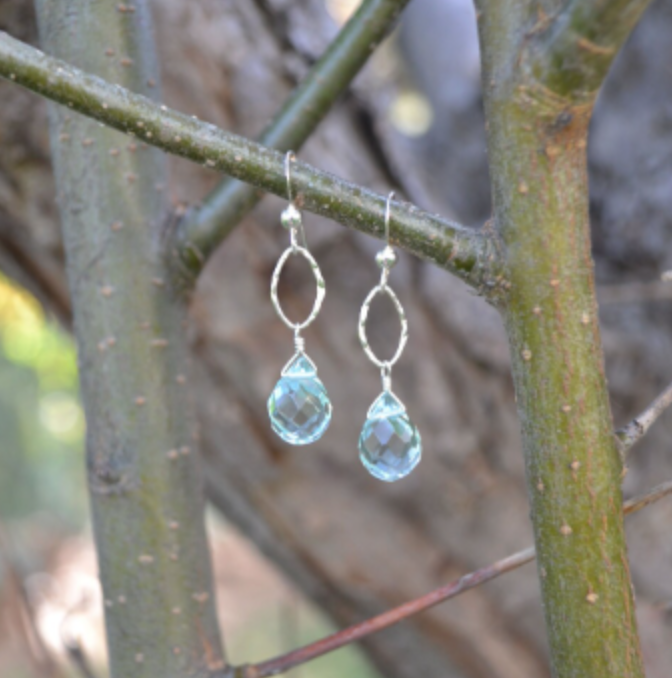

Origins: Chrysoprase is a variety of chalcedony (definition: a cryptocrystalline [aka microcrystalline – composed of fine crystals] form of silica) that contains small quantities of nickel, which provides its green color. Chrysoprase is normally a bright apple-green. In the Australian deposits, chrysoprase occurs as veins and nodules with brown goethite (definition: an iron oxyhydroxide containing ferric iron), which is the main component of rust and bog iron ore.
Locations of Deposits: Australia, Brazil, Germany, Poland, Russia, and the United States (Arizona & California)
History: The word chrysoprase comes from the Greek words “chrysos”, meaning “gold” and “prasinon”, meaning “green”. The Greeks, Romans, and Egyptians used this stone to make seals, signets, jewelry, and other objects because of its vivid color. It was a favorite stone of Frederick the Great of Prussia and decorates many buildings in Prague.
Metaphysical Properties: Chrysoprase is a stone of prosperity, power, and good fortune. It is also thought to be a stone for divine truth, joy, happiness, and healing. It helps to clarify problems, protect one on sea voyages, and shield one from negativity.
Monikers:
“The Stone of Venus” – a common name for green stones
“Australian Jade” – called because the highest quality Chrysoprase is found in Queensland, Australia
Other Information:
Stone of the Zodiac sign Libra (Sept. 24 – Oct. 23)
Origins: Fossil coral is more accurately referred to as “agatized coral” or “agatized fossil coral”. It is considered to be a type of agate, rather than a type of coral, and should not be mistaken for endangered or protected reef coral or precious coral. It is formed when the calcium carbonate remains of prehistoric coral are replaced by silica. The entire process of fossilization through replacement with agate can take over 20 million years.
Corals are marine mammals, and fossil corals are their preserved skeletons. Flower-like patterns are often left in the stone. Colors can range from white and pink, to brown, gray, black, yellow, and red, depending on weathering, oxidation, and the original mineral content.
Locations of Specimens: Indonesia and the United States (Georgia & Florida)
History: Since the beginning of the 1st millennium, coral has been highly prized as a gem because it was believed to have mysterious, powerful, and sacred properties. Ancient Egyptians placed coral in the tombs of the deceased to protect against evil spirits, and Romans hung branches of coral around the necks of their children to protect them from danger.
Metaphysical Properties: Fossil Coral is thought to carry many strong metaphysical properties because it is a combination of both coral and agate. It is believed to be a grounding stone and is good for bringing about change. It may be useful as a protective and healing stone.
Monikers:
“Agatized coral” or “agatized fossil coral”
Other Information:
Agatized fossil coral is the official Florida state rock
Associated with the Zodiac signs Gemini (May 22 – June 21) & Scorpio (Oct. 24 – Nov. 22)


Origins: Laguna Lace Agate is a variety of banded chalcedony (definition: a cryptocrystalline [aka microcrystalline – composed of fine crystals] form of silica composed of very fine intergrowths of the minerals quartz and moganite). Agates are classically associated with volcanic rocks and can be common in certain metamorphic (definition: denoting rock that has undergone transformation by heat, pressure, or other natural agencies) rocks.
Laguna Lace Agate a variety of Mexican Crazy Lace Agate. It is prized for its tight banding and vibrant colors. It comes in shades of red, milky white, and gray, as well as yellow, gold, and brown. Druse crystals may appear in the rough stone or its cavities.
Locations of Deposits: Chihuahua, Mexico
History: Agate was discovered and named by the Greek philosopher, Theophrastus, sometime between the 4th and 3rd centuries B.C. Agate is commonly used in the art of hardstone carving.
Metaphysical Properties: In general, agates may be used for strength, stabilization, memory improvement, and boosting energy. Laguna Lace Agate is thought to bind groups tightly together and is therefore beneficial for educators and counselors. It also has warm and protective properties that
Monikers:
Origins: Lapis Lazuli means “the blue stone” and is often referred to as simply “lapis”. This stone is not a single mineral but it is primarily composed of lazurite, calcite, and pyrite. It is characterized by either whitish or yellowish matrix or feathering. It can also be flecked with pyrite.
Locations of Deposits: Afghanistan, Angola, Argentina, Canada, Chile, India, Italy, Myanmar (Burma), Pakistan, Russia, and the United States (California & Colorado)
History: Lapis Lazuli has been used as jewelry as early as prehistoric times and was used as a pigment in paint during the Middle Ages. It is believed to have been highly prized by many ancient civilizations, including Egyptian, Chinese, Roman, and Greek. Lapis Lazuli even decorates the funeral mask of the ancient Egyptian pharaoh ‘King Tut’.
Metaphysical Properties: Lapis is a stone of truthfulness, inner power, and organization. It is said to facilitate self-knowledge, self-expression, and bring deep inner peace. It is thought to stimulate higher levels of the mind, encouraging clarity, openness, and objectivity. It is also considered to release depression and enable one to find enlightenment.
Other Information:
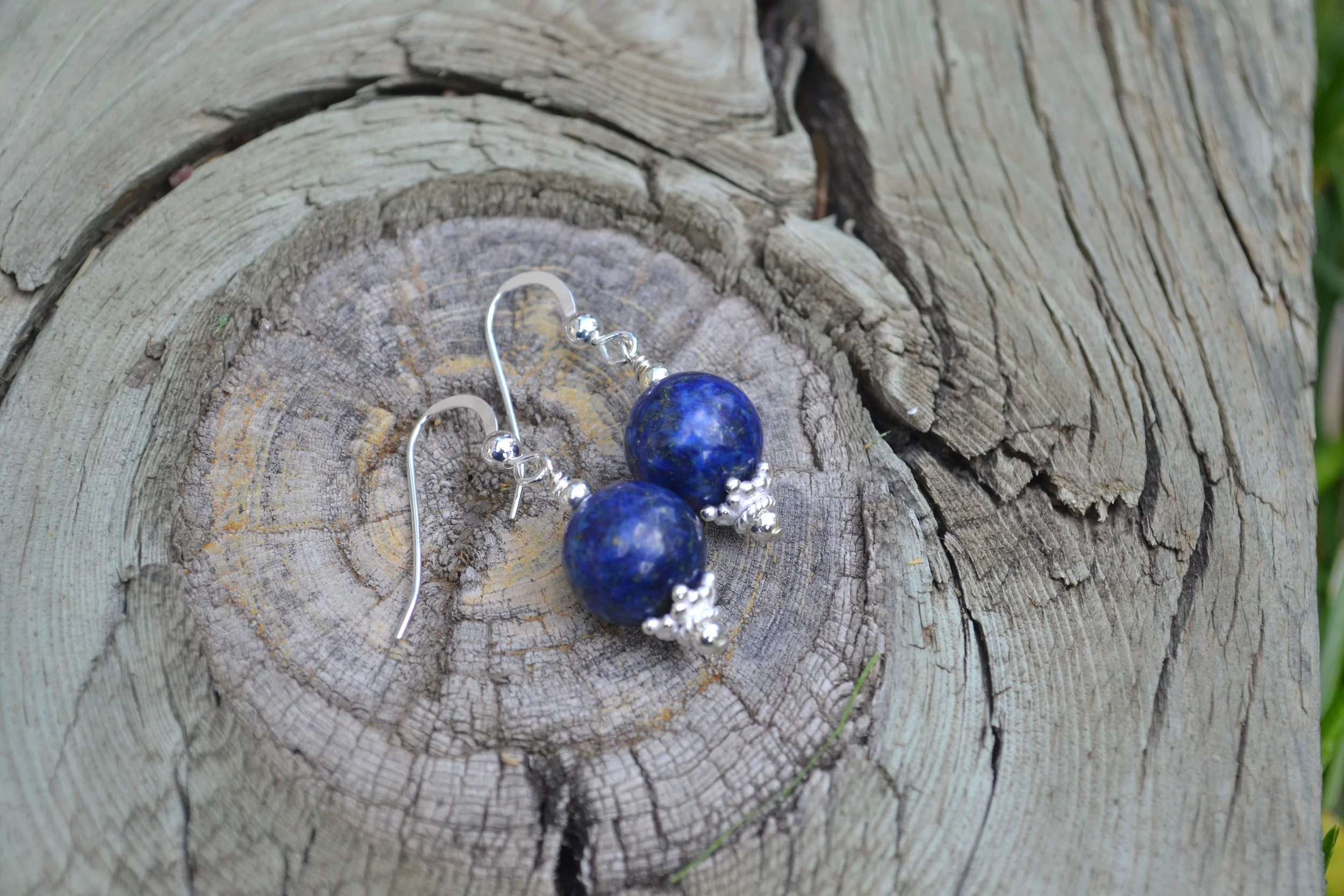

Origins: Malachite is a copper carbonate hydroxide mineral. It forms in botroyoidal (definition: resembling a bunch of grapes), fibrous, or stalagmitic (definition: resembling an inverted stalactite, formed on the floor or a cave) masses, usually from the weathering of copper ores.
Locations of Deposits: Australia, Democratic Republic of Congo (Zaire), France, Mexico, Namibia, Peru, Russia, the United States, as well as Israel and Egypt, according to archeological evidence
History: The name malachite derives from the Greek “molochitis”, which means “mallow-green stone”. Malachite was used in making green paints, up until the 1800s.
Metaphysical Properties: Malachite is a stone of transformation and love. It is believed that malachite enhances expression, peace, physical endurance, and emotional clarity. It helps bring harmony into one’s life, as well as enhances knowledge and patience. Furthermore, malachite may protect against danger and illness, release suppressed emotions, balance relationships, and facilitate insight.
Monikers:
“Stone of Transformation” – assists one in changing situations and provides for spiritual growth; draws out impurities
“Silver Peak Jade” – a misleading name for Malachite, used as a Jade imitation
Other Information:
July birthstone
13th anniversary gemstone
Stone of the Zodiac signs of Scorpio (Oct. 24 – Nov. 22) & Capricorn (Dec. 22 – Jan. 20)
Origins: Ocean Jasper, also known as Sea Jasper, is a type of Orbicular Jasper with small, tight, concentric (definition: form of banding where the bands are circular, forming rounded or oval-shaped rings around a central point) ring formations. This stone comes in a wide range of colors; it is most commonly seen as green, brown, and white, but it may also have shades of yellow, pink, and red. Some specimens feature pieces of sparkling druse quartz within the stone.
Locations of Deposits: Exclusively Northern Madagascar
History: The first vein of Ocean Jasper was mined from 1999-2006 and was approximately 90 feet long by 25 feet wide. This stone was first introduced to the general public at the Tucson gem show in January of 2000.
Metaphysical Properties: Jaspers, in general, are stones of protection. Ocean Jasper is a soothing stone that aids in loving both one’s self and others. It is said to cultivate patience and help in coping with change.
Monikers:
“The Atlantis Stone” – believed to be linked to the ancient city
“Sea Jasper”
Other Information:
Jasper is the stone of the Zodiac sign Leo (July 23 – Aug. 23)
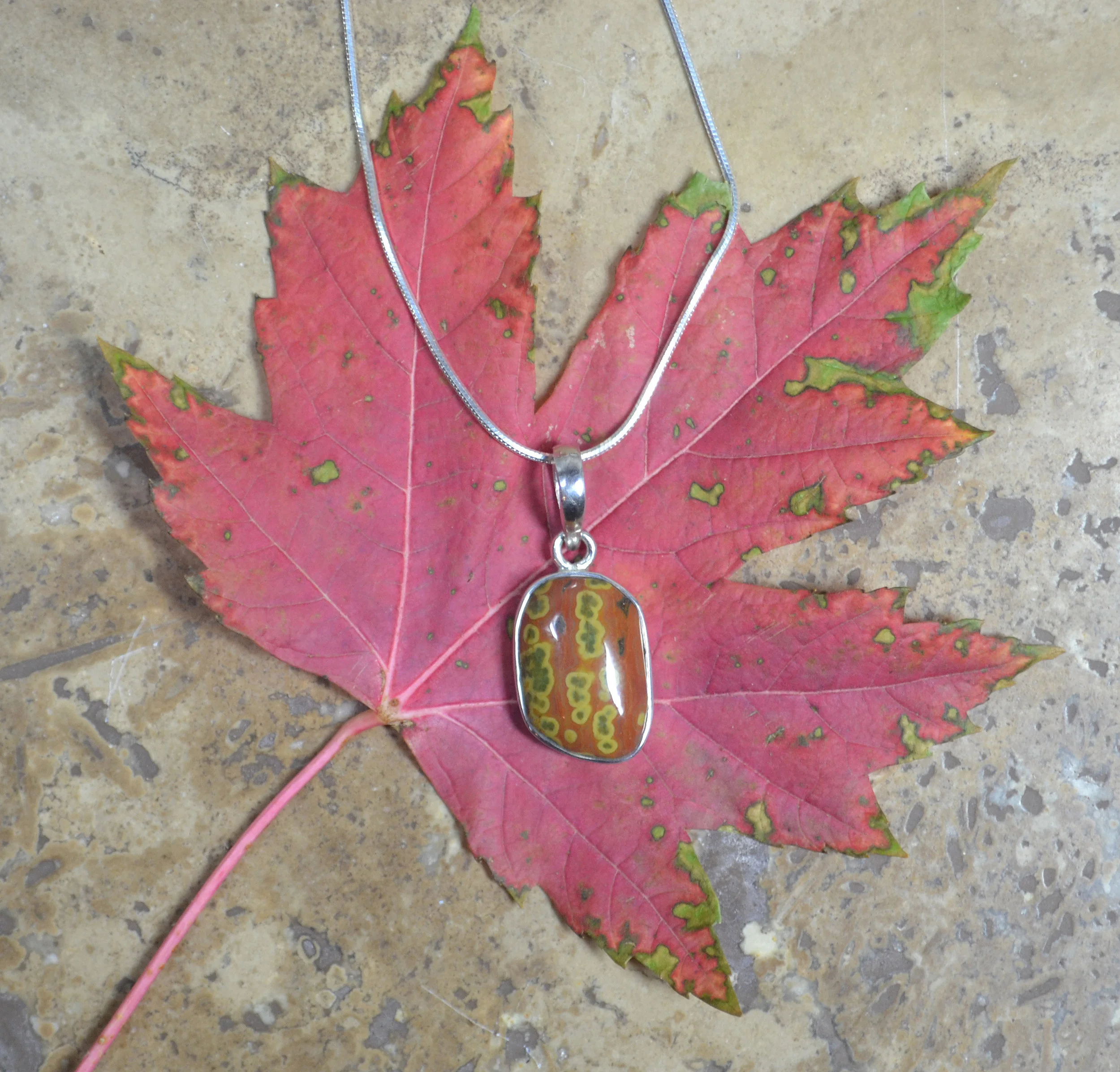

Origins: Petrified wood is a fossil that is formed through a process called petrification, in which organic living material is converted to stone. First, plant material is buried by sediment, which protects it from decay from oxygen and other organisms. Then, in a process called permineralization, groundwater flows through the sediment, replacing the original plant material with dissolved minerals such as silica, calcite, pyrite, or another inorganic (definition: not consisting of or deriving from living matter) material. The result is a fossil of the original woody material that often exhibits preserved details of the bark, wood, and cellular structures.
Locations of Fossils: Argentina, Czech Republic, Egypt, and the United States (Arizona, California, Colorado, Louisiana, Mississippi, New York, South Dakota, Texas, Utah, & Wyoming)
History: It is thought that Spanish explorers in the 1500s were among the first to see petrified wood. The most famous example of petrification is the Petrified Forest in Arizona. At one time, northeast Arizona was lowland with many rivers and streams. In the basin, there was a lush forest with huge trees, some measuring up to nine feet in diameter and 200 feet tall. Over time, the trees died, and the rivers buried them in their streambeds. Some trees decomposed, but others were buried so deep that no oxygen could facilitate decay. To the west of this area, volcanos spewed ash into the atmosphere, and wind currents carried that ash to be deposited in the silt burying the trees. Ground water dissolved silica from the ash and carried it to the buried logs, where it replaced the cell walls to complete the permineralization process.
Metaphysical Properties: Petrified wood is believed to be a grounding and protecting stone. It is said to be powerful in removing obstacles and restoring physical energy. Also, it may calm the nerves and encourage feelings of safety and security.
Other Information:
Origins: Jasper is a form of chalcedony (definition: a cryptocrystalline [aka microcrystalline – composed of fine crystals] form of silica composed of very fine intergrowths of the minerals quartz and moganite) quartz. The microcrystals in jasper are small, round grains of quartz crystal, which pack together tightly like BBs in a jar; thus, jaspers are usually opaque. Many jaspers are metamorphic (definition: denoting rock that has undergone transformation by heat, pressure, or other natural agencies) rocks.
Picture Jasper forms when mud that is rich with quartz oozed and dripped into pockets of gas formed by molten lava. The heat from this exposure turned the mud solid almost instantly; therefore, Picture Jasper is actually petrified or silicified mud. This stone is known for the masterful “pictures”, scenes, and landscapes created by banding, veining, and depositional flow patterns. Its colorful patterns result from other minerals that are present in the specimen. Picture Jasper’s earthy colors are due to high iron content.
Locations of Deposits: Australia, Brazil, Canada, Egypt, India, Kazakhstan, Madagascar, Russia, South Africa, the United States (Idaho & Oregon), and Uruguay
History: The name jasper comes from the Greek word “iaspis”, which means “spotted stone”. Jasper was ideal for engraving and was employed in the glyptic arts of many cultures.
Metaphysical Properties: Jaspers, in general, are stones of protection. Picture Jasper is thought to create harmony, creative visualization and encourage initiative in business pursuits. It is also known as an ecological stone and may be used to alleviate environmental and technological pollution. Picture Jasper is said to be a powerful emotional and physical healing stone.
Other Information:
Jasper is the stone of the Zodiac sign Leo (July 23-Aug23)


Origins: Pietersite is a mix of blue and gold Tiger’s Eye Quartz (definition: a type of quartz with yellow and brown stripes, a golden luster, and a strong chatoyance or sheen that resembles a cat’s eye). This stone’s fibrous structure has been folded, stressed, and/or broken apart via the earth’s geologic processes, only to be reformed and naturally re-cemented together by quartz. It comes in two different forms, depending on where its deposits are located. Both forms (Chinese and African) have fibrous bands of blue, gold, and/or red tiger’s eye, while the Chinese form has more striking gold, red, and blue colors.
Locations of Deposits: China and Namibia, Africa
History: Pietersite was discovered in 1962 when Sid Peters was prospecting his farmland in Namibia. Chinese Pietersite was not present on the market until 1997.
Metaphysical Properties: Pietersite is believed to discharge negative energies and to help one to see the beauty in life. It is said to enhance courage and tenacity, as well as help one relax.
Monikers:
Other Information:
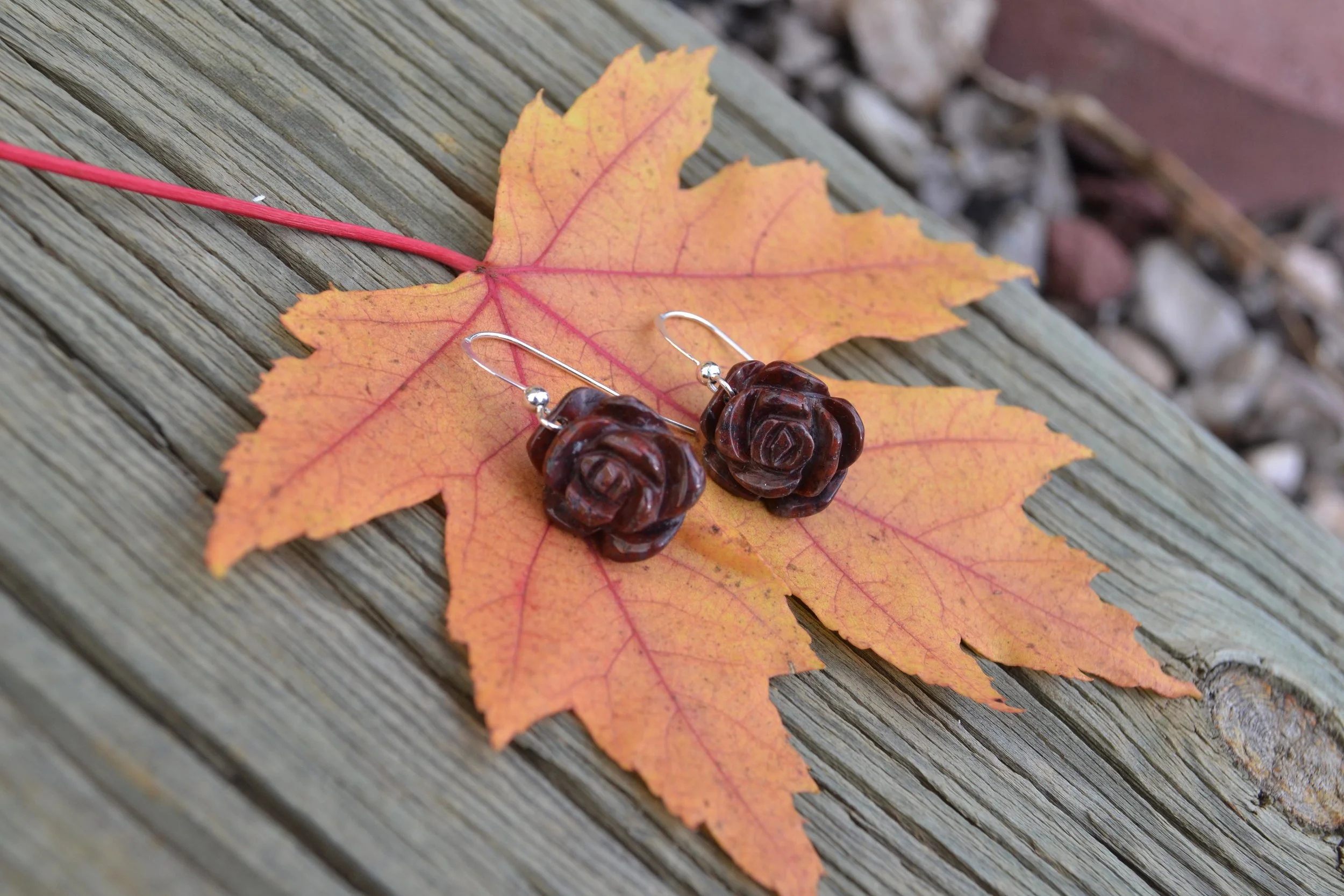
Origins: Jasper is a form of chalcedony (definition: a cryptocrystalline [aka microcrystalline – composed of fine crystals] form of silica composed of very fine intergrowths of the minerals quartz and moganite) quartz. The microcrystals in jasper are small, round grains of quartz crystal, which pack together tightly like BBs in a jar; thus, jaspers are usually opaque. Many jaspers are metamorphic (definition: denoting rock that has undergone transformation by heat, pressure, or other natural agencies) rocks.
Poppy Jasper is a form of yellow Orbicular Jasper with red concentric (definition: form of banding where the bands are circular, forming rounded or oval-shaped rings around a central point) rings. It is usually brick red with shades of brown or black, and it may contain shades of golden yellows, cream, or white.
Locations of Deposits: Spain & the United States (California)
History: The name jasper comes from the Greek word “iaspis”, which means “spotted stone”. Jasper was ideal for engraving and was employed in the glyptic arts of many cultures. Poppy Jasper was used by warriors in the Middle Ages to promote courage in battle.
Metaphysical Properties: Jaspers, in general, are stones of protection. Poppy Jasper is thought to enhance strength and will power. It is believed to inspire a positive, joyful attitude and gives one the motivation and energy to take creative action. Poppy Jasper and other red-colored jaspers are used for health and re-birth.
Other Information:

Origins: Rhodochrosite is a manganese carbonate mineral. It displays shades of pink, pale brown, gray, and creamy white but is usually rose-red in its purest and rarest forms.
Locations of Deposits: Argentina, Mexico, Namibia, Peru, Romania, South Africa, Spain, and the United States (Colorado)
History: Rhodochrosite comes from the Greek “rhodon”, meaning “rose”, and “chroma”, meaning “color”. The Incas believed that rhodochrosite was the blood of their former kings and queens turned to stone, which is what gives it the name Inca Rose.
Metaphysical Properties: Rhodochrosite is believed to boost self-confidence, bring balance to life, and help one cope with life’s problems in a graceful manner. It is also said to be a stone of love and freedom.
Monikers:
“Inca Rose” or “Rosa del Inca”– based on the Incan belief that Rhodochrosite was the blood of past kings and queens turned to stone
“Stone of Love and Balance”
“Raspberry Spar” or “Manganese Spar” – called for its color and mineral content
Other Information:
Colorado state mineral
National gemstone of Argentina
Stone of the Zodiac signs Leo (July 23 – Aug. 23) and Scorpio (Oct. 24 – Nov. 22)
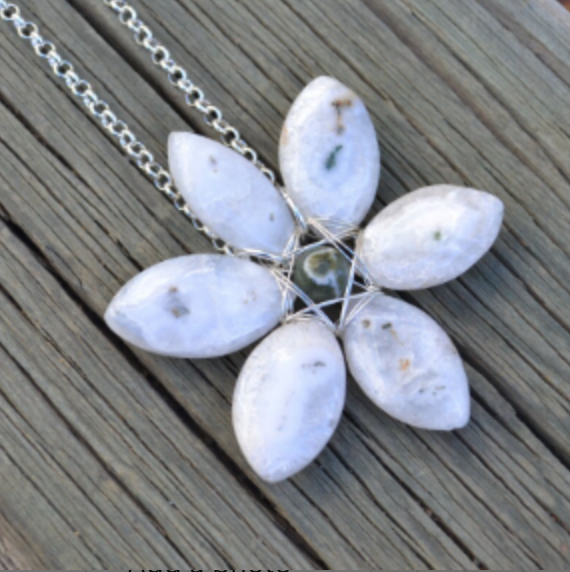
Origins: Solar Quartz is natural agatized quartz that is sliced from stalactites in clear, white or gray, with mossy inclusions.
Locations of Deposits: Brazil, Africa, & Asia
Metaphysical Properties: Solar Quartz is a protective and purifying stone. It is thought to bring emotional strength and enhance energy and power.
Other Information:
It is often dyed vivid colors, but natural Solar Quartz does not display this type of coloring